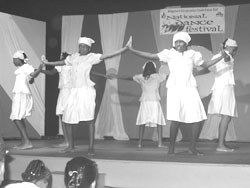Looking at our National Dance Festival

The writer of a critique analyses and evaluates the merits and demerits of something, usually a work of art. So, with the preliminary rounds of the National Dance Festival just completed, a few comments would seem appropriate. The intent is to perhaps help raise the standards of this performing art form, since we say thatâs what we want. {{more}}
A quick gloss over the fact that the preliminaries were held on two weekends instead of the advertised three; starting times were changed without much notice; and even the later starting times began late.
But on to the dancers. Those who were good were very good. And many who did not obtain the gold, clearly, were quite talented dancers.
But there were also many who simply werenât prepared. Itâs a debatable question on whether this is due to the Festival being held in September, right after the summer holiday. Because contrary to the feeling of many, dancing for the simple pleasure of it â as wonderful as that is â is not the same as dancing in a performance. Particularly when itâs before a paying audience, and itâs a national dance festival, and itâs a competition to boot. That kind of dancing requires strength, stamina, agility, concentration and coordination. Which are not easily attained after two months of sitting around, watching television and eating chips.
The judging criteria for the actual performance of the dance â the execution of movement (technique), facial expressions and uniformity â counted for about a third of the total score. Some performers transformed their dancing into an aesthetic experience for both themselves and the audience by expressively displaying the above-mentioned qualities. Others lost points if they werenât in shape physically or were just going through the motions; they looked as if they had just learned the dance and were still concentrating on their movements rather than being at the point where they could put their own expression into it.
A synopsis of the dance counted for a few points. Some groups/individuals did not turn one in or even have names for their dances (at least as of the time the programmes were printed). This might be because the choreographers did not know what the dance was about, where it was going, what emotional response they wanted to elicit. About a third of the score was given for the choreography â the use of space, the structure and the creativity used in the placement and movement of the dancers. Many dances were truly inspirational, but a little more training and experience, with more thought put into others could have raised some scores considerably.
Teachers/choreographers also need to learn a bit more about theatrical performances in general. One aspect is the costuming, which was about a fifth of the total score. Many were brilliant, but a few were inappropriate for the dances, and again it looked as if little thought was put into them, for this, a national dance festival.
Most groups did not take advantage of the lighting, which enhances a performance, helps create a mood. This might have added a point or two to the last judging criterion, overall impact.
Using such theatrical devices, however, requires a tech rehearsal where the lights, sound equipment and other technical aspects are tested and the kinks removed. Similarly, the use of costumes requires a dress rehearsal so that any skirts that might come off or other mishaps will likely take place during the rehearsal rather than the actual performance.
One great addition to this 6th National Dance Festival was that a different point system for the judging was afforded to infants/juniors and secondary students. Many more young people participated and were given an equal shot at the gold.
The finals â the best in the nation â should be an entertaining evening. And hopefully the enthusiasm of all the participants in this yearâs Festival will continue for two years until the next one, with an awakened sense of what a dance performance requires: preparation, commitment and practice.









